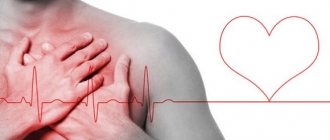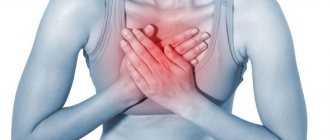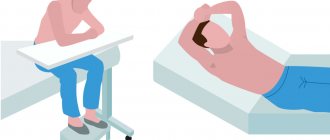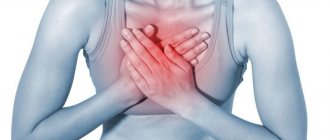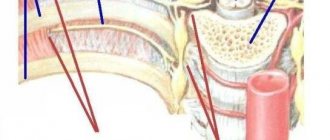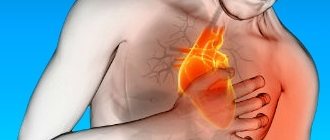Pain in the chest in the middle: causes
There can be many reasons why pain appears in the middle of the chest, so it is worth considering the intensity of the pain syndrome, its frequency and the specific location of the pain. By doing this, it will be possible to narrow down the search for pathology leading to unpleasant sensations.
Heart pathologies
Chest pain is often associated with diseases of the cardiovascular system and heart. If you feel thoracalgia all the time, this may indicate an aortic aneurysm. In this case, pain in the left or right side of the chest is felt for a long time, and it will become stronger whenever the person moves from rest to physical activity. The condition can only be treated surgically, so if this diagnosis is confirmed, hospitalization will be required. Pain in the center of the chest in front may also appear if pulmonary embolism develops. The pain becomes more severe when you inhale, and taking analgesics can suppress it. Compressive pain may indicate that a person has exertional angina, and pain may also be a symptom of myocardial infarction
.
Respiratory damage
If pain appears in the front center of the chest, and you feel shortness of breath, cannot breathe deeply, have a cough and shortness of breath, the problem may be the occurrence of pulmonary diseases, which include tracheitis, pneumonia, bronchitis, pleurisy and some others. The same symptoms can occur with diseases of the diaphragm.
Injuries
Pain in the front of the chest, in the middle, or between the ribs can occur in a person who has had an accident, been involved in a fight, or damaged the structure of the chest due to a fall or blow. Such pain intensifies when he tries to turn around, bend over, take a deep breath, and is explained by the fact that blood vessels rupture, the periosteum is damaged, cracks and fractures form. In such a situation, at rest, the pain syndrome can disappear almost completely, which gives a person false confidence that there is no need to see a doctor.
Spinal diseases
The most common reason why the chest hurts in the middle is osteochondrosis, if we talk about pathologies of the spinal column. Pain with osteochondrosis can be constant or manifest itself in the form of attacks. The pain will be of the same intensity and manifestation with radiculopathy in the thoracic spine. Pain syndrome may also indicate an intervertebral hernia and congenital anomalies in the structure of the spinal column.
Neurological diseases
The causes of pain in the chest in the middle can be neuralgic in nature. The most common diagnosis in this case is intercostal neuralgia, in which there is a lot of pain in the sternum, radiating to the back under the shoulder blade, which is why it is easy for a person to confuse the pain with heart pain.
Problems with the esophagus
Pain in the shoulder blades and in the middle of the chest may be associated with pathologies of the esophagus. The cause in this case is usually a spasm, which manifests itself more often in the morning or after eating. Pain in the chest area is relieved by taking antispasmodic drugs. Often spasms of the esophagus are accompanied by spasms of the muscular walls of the stomach.
Treatment
Help before diagnosis
Heaviness in the chest occurs when various organs and systems are affected, so self-medication at home is unacceptable and is fraught with the progression of the underlying disease and the development of complications. Patients experiencing chest discomfort are advised not to delay contacting a therapist. If squeezing pain is felt in the chest, the person experiences suffocation, febrile fever, and requires emergency medical attention.
Conservative therapy
Treatment measures are selected after identifying the causes of the condition. Heaviness in the chest does not require special symptomatic therapy and disappears after eliminating the underlying pathology. All patients are prescribed a gentle motor regimen, maximum limitation of stress and traumatic factors. Medicinal effects include drugs from the following pharmacological groups:
- Antianginal agents
. Used in combinations for long-term therapy of coronary heart disease. They are supplemented with antiplatelet agents to prevent myocardial infarction and thrombosis. Nitrates are recommended to relieve angina attacks. - Anti-inflammatory drugs
. Nonsteroidal anti-inflammatory drugs are indicated for myocarditis and pericarditis, acute respiratory diseases. They act pathogenetically and also relieve discomfort and pain. If nonsteroidal drugs are ineffective, corticosteroids are taken. - Antibiotics
. Antimicrobial drugs are prescribed for pneumonia, pleurisy, purulent bronchitis as etiotropic treatment. Penicillin antibiotics are effective for inflammatory lesions of the heart due to rheumatism. To treat tuberculosis, 3-4 specific drugs are combined. - Antiallergic drugs
. Leukotriene receptor antagonists and mast cell membrane stabilizers are used for basic therapy of bronchial asthma. Classic antihistamines are used as pathogenetic therapy for many inflammatory processes with an allergic component. - Metabolic drugs
. To improve the delivery and utilization of oxygen in the myocardium under conditions of ischemia, it is necessary to take cytoprotectors. Therapy is enhanced with ascorbic acid and B vitamins, which accelerate metabolic processes in the body.
How to relieve pain. First aid
Often a person who has pain in the middle of the chest does not know what to do in such a situation. Some people experience so much pain that they faint. In this case, severe fear is observed, the pulse rate increases, and the skin turns pale. The first thing to do if a person suddenly experiences severe pain in the sternum, internal organs and spine:
- call an ambulance;
- put the person in bed, slightly raising his legs;
- remove clothes that constrict the chest and interfere with breathing, give a nitroglycerin tablet, which will dilate the blood vessels and improve the condition of the victim.
Also, if a person has pain in the middle of the chest, it is best to ask everyone present to leave the room and ensure complete rest for the patient until the ambulance arrives.
Lump in the esophagus as a symptom of digestive system disease
Most often, a lump in the esophagus is a gastrointestinal problem
This reason for the appearance of a coma in the esophagus is the most common among other pathological conditions. Problems with the muscle sphincter that separates the esophagus from the stomach can cause stomach contents to back up into the esophagus. The acidic environment of gastric juice, which contains half-digested food, is irritating to the walls of the esophagus, which is not adapted to such contents.
This pathology is called a symptom of reflux exophagitis, it is accompanied by heartburn, and if repeated frequently, it can lead to the development of a malignant tumor of the esophagus. To clarify the diagnosis, a gastroscopy and consultation with a gastroenterologist will be required. If the treatment prescribed to them does not lead to positive results, it is possible to perform surgery on the muscle sphincter.
A hiatal hernia can cause a lump in the esophagus. It is accompanied by heartburn, chest pain and frequent, uncontrollable hiccups. The physiological reason for this condition is displacement of the diaphragm muscles due to prolonged coughing, frequent constipation, excess weight, hereditary predisposition, and mental stress.
The hernia must be distinguished from disorders of the cardiovascular system and qualified treatment must be carried out. An untreated hernia can cause reflux esophagitis.
Diagnostics
The first thing the doctor will do is interview and examine the patient, which will allow him to narrow the search for pathology based on associated symptoms. After this, various diagnostic procedures may be prescribed to determine the cause of the pain. Magnetic resonance imaging may be helpful
or
computed tomography
,
x-ray
, ultrasound, blood tests, etc. This will determine why pain occurs in the middle of the chest, which radiates to the back, upper limbs or ribs.
How does a lump in the esophagus manifest itself?
A lump in the esophagus is a very unpleasant sensation
A description of this symptom is found in the works of the great ancient physician Hippocrates. He considered a lump in the esophagus to be a manifestation of hysterical natures. Since then, the idea of a coma in the esophagus has changed somewhat. It is characterized by the following signs:
- Difficulty swallowing and breathing.
- Sensation of a foreign body in the area of the esophagus.
- Constant desire to cough, to swallow obstruction.
- Feeling of lack of air, suffocation.
- Fear of suffocation, choking (especially in sleep).
- Hoarseness, pain when talking or eating.
Such sensations are not always permanent; they can manifest themselves after taking a certain body position, or after eating, mental stress, or the appearance of strong emotions.
Which doctor should I contact?
If you are able to visit the clinic yourself, you can make an appointment with a GP
. He will determine the approximate cause of the pain and the direction of further search, and will also give you directions for diagnostic procedures and, if necessary, to specialized specialists. If there is acute pain in the middle of the chest, it is difficult and difficult to move, you cannot get out of bed without pain, call an ambulance. After examining you at home, a specialist will provide first aid and determine whether you need to be taken to the hospital.
Thyroid problems and esophageal conditions
Pathologies of the thyroid gland associated with its increased or decreased function (hypothyroidism and hyperthyroidism) can cause a feeling of a lump in the esophagus. If, at the same time as this symptom, you experience irritability, a feeling of chilliness, or, conversely, constant sweating, dry and brittle nails, hair, and memory impairment, you may need to consult an endocrinologist. Causes of thyroid dysfunction:
- Hormonal changes in the body.
- Iodine deficiency in food and drinking water.
- Metabolic disorders.
To clarify the diagnosis, you will have to do an ultrasound of the thyroid gland and donate blood for the presence of its hormones.
Diseases and pathologies of the heart
Often, when inhaling, pain appears in the left chest if there is a heart problem. In this case, there may be quite a few reasons, and only an experienced pulmonologist
.
Pericarditis
Pericarditis is an inflammation of the heart sac - the outer lining of the heart, which is called the “pericardium”. The nature of such a disease can be infectious, rheumatic, or result from a heart attack. With pericarditis, not only does pain appear when inhaling on the right or left side of the chest; the condition is often accompanied by severe weakness, as well as shortness of breath if fluid leaks between the layers of the pericardium. Pericarditis with effusion can develop into suppuration and cause compression of the heart by accumulated secretions.
Pulmonary embolism
This is the name of the condition when the pulmonary arteries stop passing blood, i.e. clogged. This is a consequence of a blood clot (thrombus), drops of fat, bone marrow, catheter element or other foreign body entering the arterial bed. In this case, when inhaling, pain occurs in the left side of the chest, and the person needs urgent medical attention.




